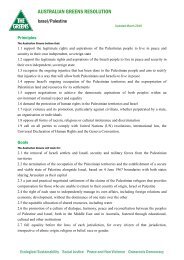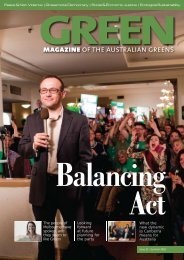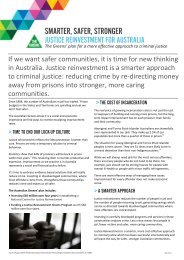news & views - Australian Greens
news & views - Australian Greens
news & views - Australian Greens
Create successful ePaper yourself
Turn your PDF publications into a flip-book with our unique Google optimized e-Paper software.
letters to editor<br />
Should the <strong>Greens</strong> support<br />
wind farms?<br />
When environmental vandalism is<br />
an issue the <strong>Greens</strong> always raise<br />
strident objections at any whiff<br />
of misinformation aimed at them.<br />
As a Green, I am no exception.<br />
In the last Green magazine,<br />
Mark Diesendorf alleged that<br />
‘bird kills are rare’ (p.9). Bat kills<br />
are presumably so extremely<br />
rare as not to merit a mention.<br />
Is Dr Diesendorf aware of the<br />
international outcry against wind<br />
farms on the grounds of landscape<br />
desecration alone – an outcry that<br />
can’t be dismissed as just NIMBY<br />
interests?<br />
When powerful energy companies<br />
weigh in with their consultants,<br />
whose reputation and income<br />
is derived from shepherding<br />
developments through the<br />
convoluted appeals process, it<br />
is not surprising that the voices<br />
of the affected little people are<br />
seldom heard. It is not difficult,<br />
using expensive senior counsel,<br />
for power companies to make<br />
challenges by local interest groups<br />
so daunting.<br />
Let me present Dr Diesendorf<br />
with some inconvenient facts.<br />
The Woolnorth wind farm in NE<br />
Tasmania kills the endangered<br />
Wedge-tailed Eagle regularly, not<br />
rarely. The numbers are not huge<br />
but this new (and expanding)<br />
wind farm is proving lethal, even<br />
in its infancy. You don’t have<br />
to kill many top predators to<br />
upset the balance. In Tasmania<br />
independent ornithologists are<br />
already predicting local extirpation<br />
of this eagle. How ironic it is that,<br />
in almost every confrontation<br />
with the Tasmanian Government,<br />
whether logging the Wielangta<br />
blue gum forest or the logging<br />
of old-growth forests elsewhere<br />
in Tasmania, the <strong>Greens</strong> always<br />
<strong>news</strong> & <strong>views</strong><br />
proclaim the Wedge-tailed Eagle as<br />
a vehicle for conservation policy.<br />
At Woolnorth almost as many bats<br />
(Goulds Wattled Bat) are being<br />
killed as birds. There is increasing<br />
evidence that the pressure<br />
gradient near the 300kmph, 45m<br />
spinning blades is enough to burst<br />
blood vessels of small animals,<br />
leaving no sign of external injury.<br />
So bats, and perhaps birds, don’t<br />
have to actually collide to be killed.<br />
However, in a wind farm that is<br />
presently doubling in size - though<br />
small by world standards - how<br />
significant at a population level are<br />
these kills?<br />
In the USA a Government Report<br />
to Congress (Sept 2005) stated<br />
that 1000 hawks are killed in<br />
Northern California by wind<br />
power facilities each year. In the<br />
mountains of West Virginia over<br />
2000 bats were killed by one<br />
development in a year. Relevant?<br />
Yes, because in his article Dr<br />
Diesendorf states that by 2040<br />
wind power could supply a massive<br />
20% of Australia’s energy! How<br />
many modern giant wind turbines<br />
would be needed to produce this<br />
20% and where would they be<br />
sited? In his calculation of how<br />
to achieve a 20% wind power<br />
contribution I hope Dr Diesendorf<br />
remembers that nowhere in the<br />
world does output from turbines<br />
ever reach installed capacity. The<br />
average output from Germany’s<br />
largest operator is around 11% of<br />
installed capacity. This operator<br />
owns over 40% of Germany’s<br />
wind energy production. It is<br />
never 100% and 80% is a rare best<br />
(Financial Review 11/04). And what<br />
takes up the slack? Conventional<br />
thermal power stations on call,<br />
inefficiently ticking over to cover<br />
base load.<br />
The <strong>Australian</strong> solution to ramp<br />
up efficiency is to develop in high<br />
wind energy coastal areas – not<br />
exclusively, but overwhelmingly. A<br />
press release by the wind energy<br />
lobby AUSWEA states that ‘To<br />
suggest that wind turbines will<br />
be installed in a given location<br />
simply because it is windy is<br />
ludicrous’ (Media Release 1/05).<br />
What a relief! But wait a minute,<br />
why is it that in the forthcoming<br />
development in NE Tasmania<br />
(Musselroe) of 42 turbines, 11<br />
will be placed in what the lead<br />
consultants agreed is a bird<br />
sensitive area, and a further 8<br />
within 500m of the coast in the<br />
eastern section. The same press<br />
release announces that AUSWEA<br />
and National Trust are ‘working<br />
together, so that significant<br />
landscapes be identified’ and that<br />
they are ‘together working on a<br />
joint Landscape Values Project<br />
to develop mutually agreed<br />
methodologies for landscape<br />
assessment’. Well, that should<br />
make Dr Diesendorf’s NIMBYS<br />
relax and celebrate. A pity though,<br />
that this wasn’t done before wind<br />
farm development got underway.<br />
At Musselroe there are two<br />
landscape prominences in an<br />
otherwise flat landscape. One is a<br />
named hill with a trig point. Each<br />
has a turbine on it, higher than<br />
the hill itself. Both hills overlook<br />
a large lagoon where the State’s<br />
highest ever count of vulnerable<br />
Hooded Plovers was made. Perhaps<br />
the presence of turbines is a good<br />
way of sanitising nearby wetlands<br />
of birds so that collision mortalities<br />
are not so worrisome.<br />
It may be time for the <strong>Greens</strong> at<br />
a national level to consider how<br />
wind farms fit in with the values<br />
which the <strong>Greens</strong> represent. Wind<br />
farms are not environmentally<br />
neutral. If the <strong>Greens</strong> are prepared<br />
to go through such a long<br />
– and worthy – fight to save the<br />
forests with all the financial and<br />
emotional costs involved, it would<br />
be consistent to regard wind<br />
farm development with the same<br />
scepticism with which they regard<br />
the woodchip industry. Both are<br />
potent adversaries to the values<br />
which I hope we share.<br />
Ralph Cooper<br />
Member Tasmanian <strong>Greens</strong><br />
Conservation Officer<br />
<strong>Australian</strong> Wader Studies Group<br />
(Birds Australia)<br />
*Letters to the Editors may be<br />
edited for length. They do not<br />
necessarily reflect the <strong>views</strong> of<br />
the <strong>Australian</strong> <strong>Greens</strong>.<br />
PAGE 3 Autumn 2007 ISSUE 22












